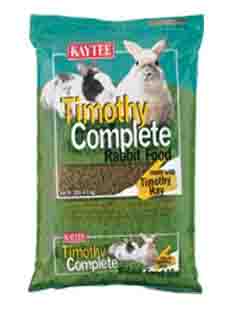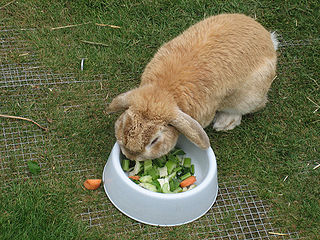Guide to Rabbit Food, Nutrition and Diet
Rabbit food selection and landing on a diet for your pet is a
matter of trial and error due to the sensitive and complex nature of
the digestive tract. Landing on the best rabbit diet can be
a little
more work than some inexperienced rabbit owners may anticipate. One
area of care that some potential rabbit owners frequently underestimate
is feeding. Feeding your rabbit is not difficult, but does require a
greater time investment than does feeding a dog or a cat. Rabbit Food for Young Pets
Young rabbits will start to eat vegetables and hay at age 2 to 3 weeks. Start with the hay followed by feeding one vegetable at a time. If you notice any digestive problems such as lose stools, then stop the vegetables and start again in several days. If you notice that any age rabbit produces soft stools after introducing a new food, then either reduce the size of the food or eliminate it from the diet. If the stools are watery or diarrhea, the most likely cause is a rabbit health related problem such as parasites.
A Rabbit Diet Should Consist of Timothy Hay, Fresh Vegetables and Pellets. Fruit is provided as a treat
Pictured: Kaytee Timothy Complete Rabbit Food Pellets
Rabbit Food Basics
Fresh Hay is the Foundation of a Rabbit DietThe foundation of your rabbit’s diet is a continuous supply of fresh grass hay. Timothy hay is most commonly used. Alfalfa hay is commonly available in pet stores, but it is not recommended for rabbits. Alfalfa is a legume, not a grass, and is much higher in calories and protein than the rabbit requires, and too much protein in the diet can lead to medical problems. The hay should be kept in a clean, dry place that is easily accessible to the rabbit at all times. Some rabbit owners will use shallow plastic bins or unused litter pans to contain the hay. The hay bin should be emptied out every few days to make sure that uneaten hay is not accumulating and becoming stale. Hay should be used within a few months of it’s being cut before it loses its nutritional value, so if you are getting the hay from a private supplier, just be sure that it is fresh.
Grass hay not only supplies your rabbit with crucial nutrients, but also allows the rabbit plenty of chewing to help keep his teeth worn down to an appropriate length. Without appropriate chewing materials, your rabbit’s teeth could become overgrown and cause serious medical problems. Wooden chew toys can be provided as supplemental chewing materials if your rabbit seems to enjoy them.
Fresh Vegetables for Important Nutrients
In addition to grass hay, your rabbit will need 3 to 6 types of fresh vegetables on a daily basis. Leafy greens, such as kale, romaine lettuce, collard greens, or turnip greens provide important nutrients and your rabbit will love them. Leafy greens should be provided in fair amounts every day.
Non-leafy vegetables, such as carrots, celery, broccoli, and cabbage can also be given every day in smaller amounts. If providing lettuce, opt for dark greed and red.
Avoid light green or iceberg lettuce and cucumbers as these can cause diarrhea in some rabbits. Also do not feed too much cabbage since it can cause enlarged thyroid glands as well as digestion issues.
The water contained in vegetables also helps with the rabbits gastrointestinal system. As a general guide, a 6 lb rabbit diet should consists of 1.5 to 2.5 cups of fresh vegetables/day. If the amount changes the consistency of the stool, then pull back to a smaller quantity. It may take some experimentation.
Start by feeding just one type of vegetable in small pieces without over feeding the rabbit. After a week, introduce another and then another. If you notice any change in the feces such as soft stools or diarrhea, then either pull back to smaller pieces or eliminate the newly added food.

Leafy Greens are an important nutritional component of the Rabbit Diet
Source: Wikimedia, Greg Hewgill
Fruit is a Snack
Fresh fruits, such as strawberries, apples, and banana can be provided as a snack. Fruits are much higher in sugar than vegetables, so it is important to give them only in very small amounts – no more than a couple of teaspoons for a medium-sized rabbit. They are a good source of vitamins and minerals. Most rabbits can digest fruit, although in a minority of pet rabbits it may cause gas and watery stools.
Fruits that are tolerated well by most rabbits include:
- Apple with no seeds
- Banana
- Raspberries
- Blackberry
- Blueberries
- Cowberry
- Seedless Grapes
- Mango
- Melons
- Orange with no seeds
- Papaya
- Pears with no seeds
- Peaches with no pits
- Pineapple
- Strawberry
Pelleted Food
The third component of your rabbit’s diet is pelleted food. Most rabbit owners provide a pelleted rabbit food on a daily basis. Pelleted rabbit food is available at most pet supply stores, and provides your rabbit with nutrients that he may be missing or getting in inadequate amounts from his hay and fresh food. Immature rabbits can be fed as much pelleted food as they will eat, but once the rabbit is fully grown the amount should be reduced to no more than ¼ cup per 5 pounds of body weight.
Fresh Water
One last part of your rabbit’s diet should be a continuous supply of fresh, clean water. The water should be kept in an upright dispensing bottle or a sturdy dish, and should be changed every other day to prevent growth of bacteria or other pathogens.
Rabbit Foods to Avoid
The following should never be fed to a pet rabbit:- Chocolate
- Any fruit with seeds or pits
Have a Rabbit Health or Care Question for our Vet? We Will Answer it for Free!
Do you need some rabbit care advice? Just ask a question and our Vet will answer it as soon as possible.
If your question is medical or behavior related, please include information such as species, age, diet, habitat and anything related to the medical history of your rabbit.
Please upload a picture of your rabbit, especially if you believe it will help the Veterinarian. This is often the case when you are concerned with a rabbit skin disease or coat problem. Please know that we receive many questions and answer them on a first come, first served basis. If you need an immediate response, we suggest you use this online veterinary service that is available now to answer your questions.
Related Articles on Pet Rabbits:
Pet Rabbits
Rabbit Health
Rabbit Cages
Buying a Guinea Pig or Pet Rabbit
Taming a Rabbit
Pet Rabbit Odor or Smell
Rabbit Food References
The Ultimate Encyclopedia of Small Pets and Pet Care
Alderton, David
Medi Rabbit
The Ultimate Encyclopedia of Small Pets and Pet Care
Alderton, David
Medi Rabbit
Like this page? Please share it with your friends:
Comments
Have your say about what you just read! Leave me a comment in the box below.